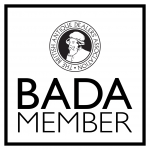
Edward Wakelin
Edward Wakelin was the son of Edward Wakelin late of Uttoxeter in the County of Stafford, baker, deceased.
He was apprenticed to John Le Sage in June 1730, on payment of £21.00. Free on 7th September 1748. By 2nd November 1747 he had joined the famous George Wickes at Panton Street, since the latter’s ledger (Garrard MSS, Victoria and Albert Museum Library) under that date shows the transfer of “a Moiety of the Stock in Trade” of Wickes to Wakelin.
First mark (modelled on that of Wickes and differing only in the initial letter of the Christian name, and that in “black letter” capital nearly indistinguishable) entered as largeworker, 17th November, 1747 (two sizes). Address: Panton Street near ye Haymarket. It is doubtful if, after this date, any plate is found with Wickes’ mark and it is obvious that Wakelin took virtual charge, at least of the silversmith’s side of the business, from then on. The ledgers from 1747 to 1760 contain stock-taking balances each year of the partnership showing first Wickes’, and then from 1750 Wickes’ and Netherton’s in debtedness in stock to the partnership and, to credit, their outgoings. The lease of the house was assigned, presumably to Wakelin (but this is not actually stated), on 2nd April 1748 for £40, and the annual rent was £40.0s.1od. No jewellery appears in the annual valuation of stock and it seems that this was no concern of Wakelin’s, presumably being in the hands of Netherton.
Second mark, in partnership with John Parker I sometime after 1758 and therefore in the missing register. Parker’s initials placed above Wakelin’s suggest that he became senior partner, and since he had been apprenticed to Wickes rather than Wakelin, this may be so. At any rate, by the 14th December 1761 the firm is self-styled Parker and Wakelin in a reference in the ledger of the time to their own daybook. The partnership appears to have lasted till 1777, when the next one of John Wakelin, Edwards’s son, and William Taylor begins.
Heal records Wakelin alone as goldsmith, Panton Street, 1747-66, and Parker and Wakelin (successors to Wickes and Netherton), (King’s Arms), Panton Street, near St James’, Haymarket, 1759-77. His obituary notice read “At Mitcham Surrey Mr. Edw. Wakelin formerly a goldsmith in Panton Street, Died 7 Feb 1784” (the Gentleman’s Magazine, p. 152). The following September Samuel Netherton, presumably as Wakelin’s executor, is recorded as paying a legacy of £20 to J. Wakelin.
How practical a craftsman Wakelin was is somewhat difficult to assess. That he had drive and business building qualities is apparent by the growth and continuity of this famous establishment. The setting up of the Crespel business must have been his idea, and it is he who must have taken the orders of half the nobility of England to enlarge their plate-closets on marriage to an heiress or elevation to higher rank. There would seem little doubt that once Lamerie was dead in 1751, the centre of production for fine work was divided between Panton Street and Thomas Heming’s establishment. The best production of Parker and Wakelin of the ‘60s and ‘70s show considerable awareness of French taste and technique, and it would be extremely interesting to know the personnel, other than the Crespels, in the workshops behind the façade of the “King’s Arms” during that time.






